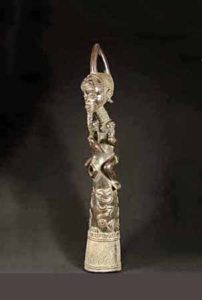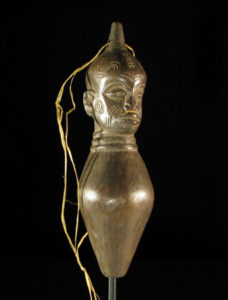Lulua
Lulua is an umbrella term, which refers to a large number of heterogeneous peoples who populate the region near the Lulua River, between the Kasai and Sankuru rivers. They migrated from western Africa during the 18th century and settled in the southern part of the Democratic Republic of the Congo (formerly Zaire). The Lulua live in small regional chiefdoms and in times of crisis elect a common leader. The role of the village chief is to insure juridical, political and social cohesion. During the late 19th century, Lulua culture underwent radical changes. In 1875, the Lulua king, Kalambam, introduces new social and religious regulations, which ended the traditional palm-wine drinking and hemp smoking.
Primarily farmers, Lulua women grow manioc as a staple crop, as well as beans, sweet potatoes, maize, yams, peanuts, and bananas. The men are responsible for clearing the forest and preparing the soil for cultivation. They also hunt, fish with nets, and trap animals in the surrounding forests. Salt is found in the region and is collected and sold to neighbors to generate income.
The Lulua statuary is remarkable in the degree of its scarification, a manifestation of a wish to be socially differentiated. These statues represent great chiefs with beards and insignia, and these effigies would be planted in the ground to protect the household when the head of the family was absent. The most famous statuettes are the mbulenga, or female charm statuettes. Then there is the chibola, maternity figures that, when worn on the belt, protected the newborn child or the baby about to be born. The protruding abdomen of the woman chibola figure emphasizes the importance of the lineage.
The Lulua also make pipes, tobacco mortars, neck-rests, hemp jars, drums, combs, small hunter’s flutes, ritual flute, and adzes.
Source: www.zyama.com


